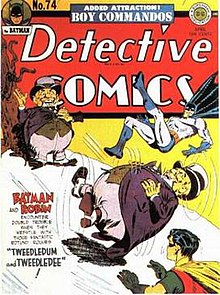
The Elizabeth Arkham Asylum for the Criminally Insane, commonly referred to as Arkham Asylum, is a fictional psychiatric hospital/prison, named after the city of Arkham which appeared first in the stories of H. P. Lovecraft, and later appearing in American comic books published by DC Comics, commonly in stories featuring the superhero Batman. It first appeared in Batman #258, written by Dennis O'Neil with art by Irv Novick. The asylum serves as a (forensic) psychiatric hospital for the Gotham City area, housing patients who are criminally insane, as well as select prisoners with unusual medical requirements that are beyond a conventional prison's ability to accommodate. Its high-profile patients are often members of Batman's rogues gallery.
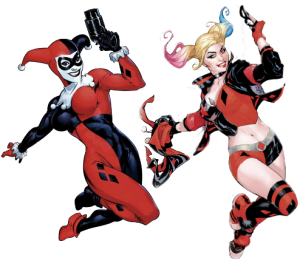
Harley Quinn is a character appearing in American comic books published by DC Comics. She was created by Paul Dini and Bruce Timm for Batman: The Animated Series as a henchwoman for the Joker, and debuted in its 22nd episode, "Joker's Favor", on September 11, 1992. While intended to appear in one episode, Quinn became a recurring character within the DC Animated Universe (DCAU) as the Joker's sidekick and love interest, and was adapted into DC Comics' canon seven years later, beginning with the one-shot Batman: Harley Quinn #1. Quinn's origin story features her as a former psychologist at Gotham City's Arkham Asylum who was manipulated by and fell in love with the Joker, her patient, eventually becoming his accomplice and lover. The character's alias is a play on the stock character Harlequin from the 16th-century Italian theater commedia dell'arte.
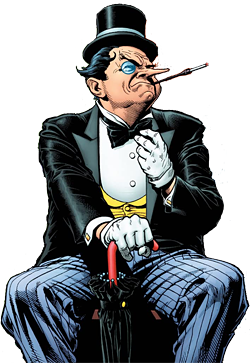
The Penguin is a supervillain appearing in American comic books published by DC Comics, commonly as an adversary of the superhero Batman. The character made his first appearance in Detective Comics #58 and was created by Bob Kane and Bill Finger. The Penguin is one of Batman's most enduring enemies and belongs to the collective of adversaries that make up Batman's rogues gallery.
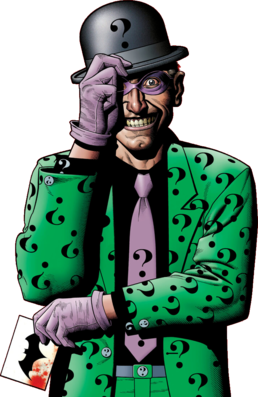
The Riddler is a supervillain appearing in American comic books published by DC Comics. The character was created by Bill Finger and Dick Sprang, and debuted in Detective Comics #140 in October 1948. He has become one of the most enduring enemies of the superhero Batman and belongs to the collective of adversaries that make up his rogues gallery.

James W. "Jim" Gordon is a fictional character appearing in American comic books published by DC Comics, most commonly in association with the superhero Batman. Created by Bill Finger and Bob Kane as an ally of Batman, the character debuted in the first panel of Detective Comics #27, Batman's first appearance, making him the first Batman supporting character ever to be introduced, eventually succeeding him as Batman from 2015 to 2016.

Bane is a supervillain appearing in American comic books published by DC Comics. Created by writer Chuck Dixon and artist Graham Nolan, he made his debut in Batman: Vengeance of Bane #1. Bane is usually depicted as a dangerous adversary of the superhero Batman, and belongs to the collective of enemies that make up Batman's rogues gallery. Possessing a mix of brute strength and exceptional intelligence, Bane is often credited as the only villain to have "broken the bat", defeating him both physically and mentally. Bane went on to kill Alfred Pennyworth in 2019 during the City of Bane storyline. He is the son of another Batman enemy, King Snake and has a clone/daughter named Vengeance, introduced in 2021.

Hugo Strange is a supervillain appearing in comic books published by DC Comics, commonly as an adversary of the superhero Batman. The character is one of Batman's first recurring villains, and was also one of the first to discover his secret identity. The character first appeared in Detective Comics #36.

The Mad Hatter is a supervillain appearing in comic books published by DC Comics, commonly as an adversary of the superhero Batman. He is modeled after the Hatter from Lewis Carroll's novel Alice's Adventures in Wonderland, a character often called the "Mad Hatter" in adaptations of Carroll. A scientist who invents and uses technological mind control devices to influence and manipulate the minds of his victims, the Mad Hatter is one of Batman's most enduring enemies and belongs to the collective of adversaries that make up Batman's rogues gallery.
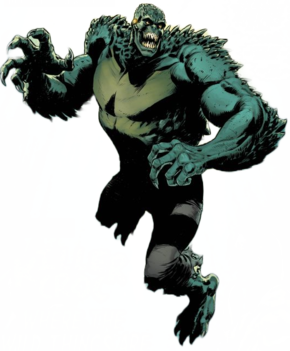
Killer Croc is a supervillain appearing in American comic books published by DC Comics. Created by Gerry Conway, Don Newton and Gene Colan, the character was introduced in Batman #357. He has become one of the most enduring enemies of the superhero Batman and belongs to the collective of adversaries that make up his rogues gallery.

Harvey Bullock is a fictional detective appearing in American comic books published by DC Comics, commonly in association with the superhero Batman. The character first appeared in Detective Comics #441 and was created by Archie Goodwin and Howard Chaykin. In animation, he appeared throughout the DC Animated Universe, voiced by Robert Costanzo. He debuted in live-action in 2014 on Fox's television series Gotham, portrayed by Donal Logue.

Firefly is a supervillain appearing in American comic books published by DC Comics. Created by France Herron and Dick Sprang, he made his debut in Detective Comics #184. Initially portrayed as a criminal who utilized lighting effects to commit robberies, Firefly was later reimagined as a sociopathic pyromaniac with an obsessive compulsion to start fires following Crisis on Infinite Earths' reboot of the DC Universe in the 1980s. This darker depiction of the character has since endured as one of the superhero Batman's most recurring enemies and belongs to the collective of adversaries that make up his central rogues gallery.
Originally created in 1967, the fictional comic book character Barbara Gordon has been adapted into various other forms of media. The character has appeared in both live action and animated television series and films, as well as in video games in her alter-egos as both Batgirl and Oracle.
Mario Falcone is a fictional character appearing in American comic books published by DC Comics. He is the son of Gotham City mob boss Carmine Falcone, the brother of Alberto Falcone and Sofia Falcone, and the uncle of Kitrina Falcone.
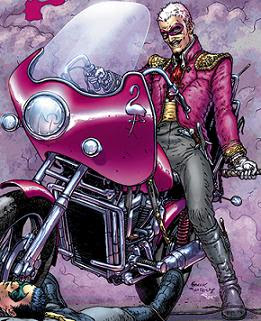
Flamingo is a fictional supervillain appearing in American comic books published by DC Comics, commonly as an adversary of Batman.

The Riddler, a supervillain in DC Comics and an adversary of the superhero Batman, has been adapted into numerous forms of media, including feature films, television series, and video games. The character has been portrayed in live-action by Frank Gorshin and John Astin in the 1960s television series Batman, Jim Carrey in the 1995 film Batman Forever, Cory Michael Smith in the 2014 Fox series Gotham, and Paul Dano in the 2022 film The Batman. Actors who have voiced the Riddler include John Glover in the DC Animated Universe, Robert Englund in The Batman, and Wally Wingert in the Batman: Arkham video games.
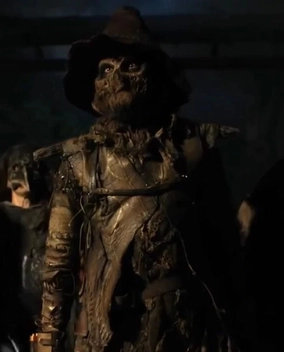
The Scarecrow, a supervillain in DC Comics and an adversary of the superhero Batman, has been adapted in various forms of media, including films, television series and video games.

The fictional supervillain Penguin, created by Bob Kane and Bill Finger, made his first appearance in Detective Comics #58. Since then, he has been adapted into other forms of media, including feature films, television series, and video games.
